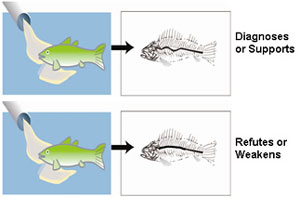Symptoms
Concept
Symptoms: Biological measurements (often at lower levels of biological organization than the effect) can be characteristic of one or a few specific causes.

Click here for more information
Examples
Consider increased levels of endocrine disrupting chemicals as a candidate cause of reduced fish abundance. What findings support or weaken the case for increased endocrine disruptors as the cause, based on symptoms?
- Supporting evidence - Necropsies of fish reveal the presence of ovotestes, and vitellogenin in serum from males. These findings are unique characteristics associated with exposure to endocrine disrupting chemicals.
- Weakening evidence - Necropsies of fish do not reveal the presence of ovotestes or vitellogenin; rather, they show that the fishes' stomachs have been tinted blue, a characteristic symptom of molybdenum toxicity.
How Do I Analyze the Data?
The presence or absence of characteristics that occur only in response to a particular stressor can be used to diagnose that stressor as the cause. Confidence in this type of evidence is increased when a larger number of characteristic symptoms are observed, or when the observed symptoms are highly specific to few potential causes. Non-specific effects are more difficult to diagnose, so this type of evidence is more helpful when impairments are defined as specifically as possible (e.g., as decreases in specific insect taxa of concern, rather than as decreases in total insect abundance).
What Evidence Would Support or Weaken the Case for a Candidate Cause?
- Data showing that a unique set of characteristics caused by a candidate cause (e.g., symptoms within the organism, the presence of indicator species) are present at the impaired site
- Data showing that one or more characteristics usually caused by a candidate cause are not present at the impaired site
- Data showing that one or more characteristics at the impaired site that are not those caused by the candidate cause are present at the impaired site
How Do I Score the Evidence?
| Finding | Interpretation | Score |
|---|---|---|
| Symptoms or species occurrences observed at the site are diagnostic of the candidate cause. | This finding is sufficient to diagnose the candidate cause as the cause of the impairment, even without the support of other types of evidence. | D |
| Symptoms or species occurrences observed at the site include some but not all of a diagnostic set, OR symptoms or species occurrences observed at the site characterize the candidate cause and a few others. | This finding somewhat supports the case for the candidate cause, but is not strongly supportive because symptoms or species are indicative of multiple possible causes. | + |
| Symptoms or species occurrences observed at the site are ambiguous or occur with many causes. | This finding neither supports nor weakens the case for the candidate cause. | 0 |
| Symptoms or species occurrences observed at the site are contrary to the candidate cause. | This finding convincingly weakens the case for the candidate cause. | --- |
| Symptoms or species occurrences observed at the site are indisputably contrary to the candidate cause. | This finding refutes the case for the candidate cause. | R |
Helpful Tips
- Laboratory tests cannot be used to refute toxic effects in the field, due to differing field and laboratory conditions.
- Absence of toxicity in laboratory experiments may be due to more acute, episodic exposures in the field, or to observed biological effects based on species, life stages, or responses that are more sensitive than those used in the laboratory.
